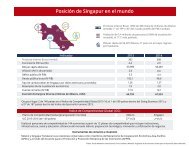basic-guide-to-exporting_Latest_eg_main_086196
basic-guide-to-exporting_Latest_eg_main_086196
basic-guide-to-exporting_Latest_eg_main_086196
Create successful ePaper yourself
Turn your PDF publications into a flip-book with our unique Google optimized e-Paper software.
the counterparties’ local currencies. This approach could also result in nonpayment bya foreign buyer who finds it impossible <strong>to</strong> meet agreed-upon obligations owing <strong>to</strong> asignificant devaluation of his local currency against the U.S. dollar. While losses due <strong>to</strong>nonpayment could be covered by export credit insurance, such “what-if” protection ismeaningless if export opportunities are lost in the first place because of a “paymentin U.S. dollars only” policy. Selling in foreign currencies, if foreign exchange risk issuccessfully managed or hedged, can be a viable option for U.S. exporters who wish<strong>to</strong> enter the global marketplace and re<strong>main</strong> competitive there.You should also be aware of any problems with currency convertibility. Not allcurrencies are freely or quickly converted in<strong>to</strong> U.S. dollars. Fortunately, the U.S. dollaris widely accepted as an international trading currency, and U.S. companies can oftensecure payment in dollars.If the buyer asks <strong>to</strong> make payment in a foreigncurrency, you should consult an internationalbanker before n<strong>eg</strong>otiating the sales contract.Banks can offer advice on any foreign exchangerisks associated with a particular currency.The most direct method of hedging foreignexchange risk is a forward contract, whichenables the exporter <strong>to</strong> sell a set amount offoreign currency at a pre-agreed exchange ratewith a delivery date from 3 days <strong>to</strong> 1 year in<strong>to</strong>the future.If you’re able <strong>to</strong> do businessentirely in U.S. dollars, you maybe able <strong>to</strong> avoid many of thedifficulties and issues related<strong>to</strong> currency conversion.U.S. Department of Commerce Trade Finance GuideTo learn more about methods of payment in international trade, foreign exchangerisk, and related <strong>to</strong>pics, you can refer <strong>to</strong> the U.S. Department of Commerce’s TradeFinance Guide: A Quick Reference for U.S. Exporters (export.gov/tradefinance<strong>guide</strong>).This concise, simple, and easy-<strong>to</strong>-understand <strong>guide</strong> was designed <strong>to</strong> help U.S. smalland medium-sized U.S. companies that are new <strong>to</strong> <strong>exporting</strong> learn how <strong>to</strong> get paidfrom export sales in the most effective manner.Payment ProblemsIn international trade, it is easier <strong>to</strong> avoid problemsinvolving bad debts than <strong>to</strong> rectify them after theyhave occurred. Credit checks and the other methodsdiscussed in this chapter can limit the risks; normalbusiness prudence is crucial <strong>to</strong> the exporter.Whenever possible, try <strong>to</strong>prevent payment-relatedissues before they happen.Nonetheless, just as in a company’s domestic business, exporters occasionallyencounter problems with buyers who default on their payment. When theseproblems occur in international trade, obtaining payment can be both difficult andexpensive. Even when the exporter has insurance <strong>to</strong> cover commercial credit risks, adefault by a buyer still requires the expenditure of both time and money <strong>to</strong> collect164U.S. Commercial Service • A Basic Guide <strong>to</strong> Exporting





